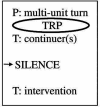Silence after narratives by patients in psychodynamic psychotherapy: a conversation analytic study
- PMID: 39679161
- PMCID: PMC11638706
- DOI: 10.3389/fpsyg.2024.1397523
Silence after narratives by patients in psychodynamic psychotherapy: a conversation analytic study
Abstract
In psychotherapy, verbal communication is central to the therapeutic process. However, when patients remain silent, it can serve various functions, such as reflecting more deeply or hesitating to elaborate on a topic. This article uses conversation analysis to examine a specific context in which silence occurs: After a patient has concluded his/her narrative, both the therapist and the patient resist the turn allocation by the respective other, resulting in mutual silence. The results indicate that both therapists and patients collaboratively generate this silence. Therapists typically end the silence with an intervention, addressing an aspect of the topic and treating the pause as intra-topic silence. The study is based on approximately 29 h of video recordings of German-speaking outpatient psychodynamic psychotherapy sessions. This research highlights the importance of therapists recognizing the different forms of silence that may emerge during psychotherapy.
Keywords: conversation analysis; narrative; psychodynamic psychotherapy; resistance; silence; therapeutic intervention; turn-taking.
Copyright © 2024 Fenner.
Conflict of interest statement
The author declares that the research was conducted in the absence of any commercial or financial relationships that could be construed as a potential conflict of interest.
References
-
- Abrahams D., Rohleder P. (2021). A clinical guide to psychodynamic psychotherapy. London: Routledge.
-
- Amar C., Nanbu Z., Greer T. (2022). Proffering absurd candidate formulations in the pursuit of progressivity. Classroom Discourse 13, 264–292. doi: 10.1080/19463014.2020.1798259 - DOI
-
- Bercelli F., Rossano F., Viaro M. (2008). Different place, different action: clients’ personal narratives in psychotherapy. Text & Talk 28, 283–305. doi: 10.1515/TEXT.2008.014 - DOI
-
- Berger I. (2011). Support and evidence for considering local contingencies in studying and transcribing silence in conversation. Pragmatics 21, 291–306. doi: 10.1075/prag.21.3.01ber - DOI
-
- Bergmann J. R. (1982). “Schweigephasen im Gespräch: Aspekte ihrer interaktiven Organisation” in Beiträge zu einer empirischen Sprachsoziologie. ed. Soeffner H.-G. (Tübingen: Narr; ), 143–184.
LinkOut - more resources
Full Text Sources


